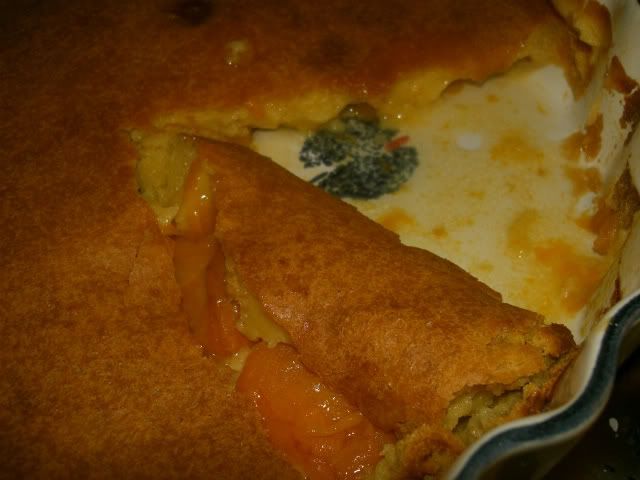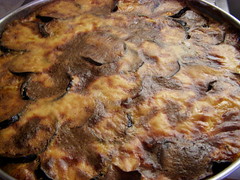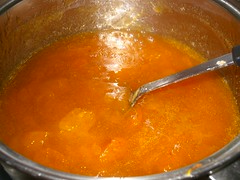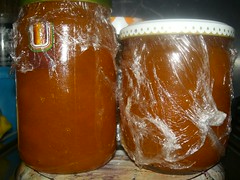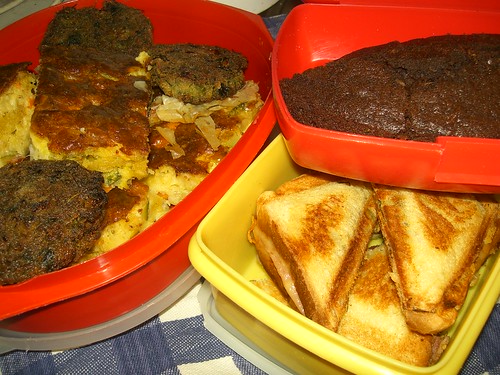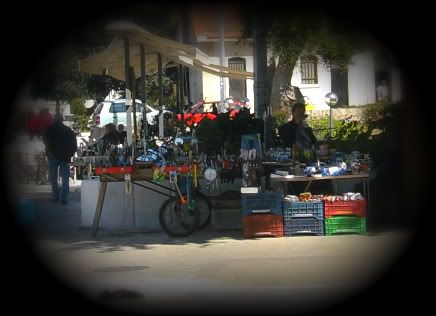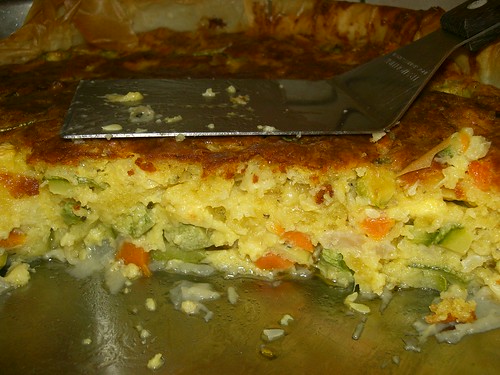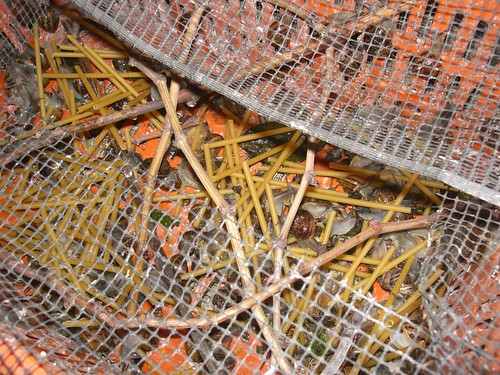(This post was featured on the home page of BlogHer on 25th June, 2008)Snails are an acquired taste. Not everyone would be happy about seeing them on their plate, except maybe at a restaurant where snails are treated like exotic decadence at a premium price. The origins of eating snails are far from luxurious. Peasants are the modern ancestors of the earliest foragers, and about the only thing that both societies had in common was that they needed to eat; snails could be sourced locally and were easy to find. Even
my mother would
forage for them in New Zealand, and they were quite large there, although not as large as the
giant African snails that are used in
the most elaborate recipe I have ever read about.
Once
snails have gone dormant, they are at the eating stage, whether they have been reared in captivity or in their natural habitat. Snails are eaten as a main meal in Crete, so a normal serving size would include about 15-20 snails per person. There are many ways to serve snails in Crete, but in our house, we cook them in a stew. This stew always contains courgettes and potatoes - another way to use up our river of zucchini. It is a classic Cretan summer meal, and a special one for me: it is one of the most time-consuming, copiously prepared meals I make, apart from
moussaka. Not everyone eats snails, but there is something for everyone to eat from the same pot that the snails are cooked in. And the most important thing to note about this meal is that all the ingredients (save the pepper) can (and were) sourced
within 10 kilometers from my own home. It is most organic, and extremely local.
TO SEE IF THE SNAILS ARE ALIVE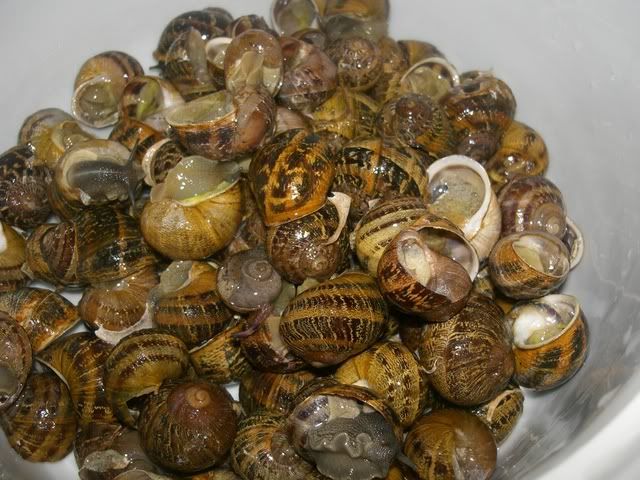 An unbroken seal
An unbroken seal is usually a sign (99%) that the snails are alive. Put the snails in the sink and run cold water over them, filling and plugging the sink with about 2cm of water. The snails should eventually start showing signs of life at this stage. If they aren't moving or creeping out of their shells, they may still be alive. Don't forget that some of them move at snail's pace. I had just come home from the beach with the children when I started preparing this dish. I let them tell me when they saw moving snails. Admittedly, this process is time-consuming. We can't all hang around all day waiting to see if they're going to make a move. A quicker way to deal with this is to pull off the seal and prod their body. They will start to produce slime almost immediately. Don't throw them into boiling water before you can ascertain whether they are alive or dead. If you don't know what a dead snail looks like, believe me,
they look pretty dead - think of a black corpse.
TO KILL THE SNAILS (
censor's warning: PG)

You don't eat live sheep, pigs and cows, do you? So it is with snails; you have to kill them before you cook them.
Michael Pollan discusses the pros and cons and the ethics involved in killing what he foraged in the
Omnivore's Dilemma in order to cook and eat it; snails are not as unpleasant as large animals, but it's certainly an experience. When you do this yourself, you may feel like a cold-blooded killer. This is why a lot of animal-friendly people prefer to buy their meat prepackaged from supermarkets. The assistant at the meat counter in a supermarket, as described by
Joanna Blythman in
Shopped, "sells you a piece of meat as if it is a euphemism for a dead animal." Have a pot of boiling water ready and toss each snail into it. No blood, no mess, just loads of slime. Don't worry about the seal that is still stuck to the shell. This will clean far more easily once it has softened in hot water. At this point, if you raped the countryside to get the snails and find you can't eat all that you gathered, you can drain them, and freeze them to cook in a winter meal or during a fasting period, as snails are considered lenten fare.
TO CLEAN THE SNAILS:The snails aren't exactly dirty; the last time they crapped was probably about 2-3 weeks before you honed in on them. Their seal is very strong and adheres to the shell as if it's been stuck with glue. For aesthetic reasons, it needs to be removed (unlike
my koumbaro, you don't really want to be eating someone else's secretions). Once the snails have been dipped into hot water, the seal can be scraped away with a sharp knife. If you prefer, this can be done at the stage where you check if they're alive; the snails will realise that they are being tampered with, and will start to produce their slime, which may put you off cooking them, so that you take them back to where you found them...
The snails are now ready to be cooked in the meal of your choice. In our house, we have them stewed in a traditional Cretan recipe.
TO PREPARE THE SNAILS FOR COOKING:
You need:about 80
snails at the cleaned stage, enough to give 4-5 servings
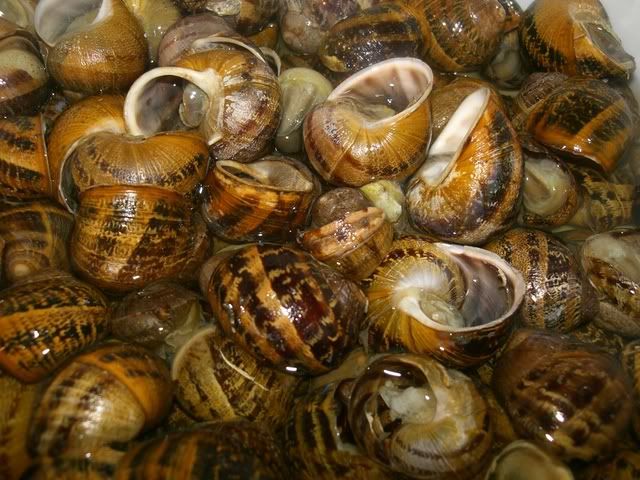
Boil the snails in salted for about 20 minutes, changing the water, changing the water once or twice (depending on how off-putting you find the residue) to get rid of the slime. I love the sound of snail shells rattling against the pot. They will now smell like an unusual species of shellfish. They will have lost their green slimy look, and you will now view them as edible. Strain the cooked snails of excess water, and place them in a bowl, covering them in wine. This is simply to make them smell nice; wine is often used in Greek cuisine to marinate meat, hence its use with snails. Let the snails marinate for a couple of hours (or overnight, as this meal CAN be cooked piecemeal - as mine was) before you add them to the main stew.
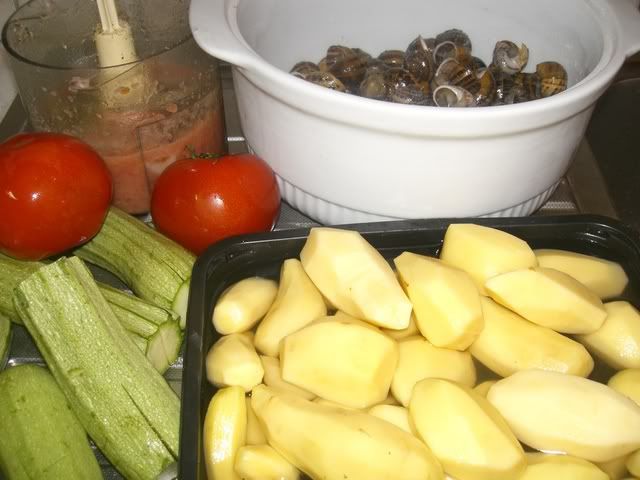
For the stew,
you need:
1/4 cup olive oil (from the village)
1 large onion sliced thinly (from our garden)
2 cloves of garlic, minced (from our garden)
10 small zucchinis (from our garden - the less mature, the better - the ones I used today were just sweating in their own juice and cooked in very little time)
20 baby potatoes (given to us by my uncles), or 4 large potatoes, chopped into large chunks - I used far more potatoes than necessary to cater for snail non-eaters
4-5 tomatoes, grated (from the garden)
salt, pepper and oregano (I have no idea where they were procured)
finely chopped parsley (optional)
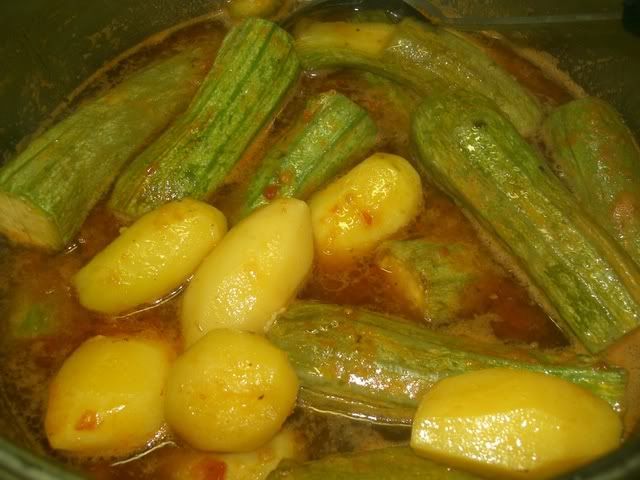
Heat the oil and add the garlic and onion. Saute till transparent. Add the potatoes and zucchinis - chop the courgettes if they are large, otherwise, leave them whole, as they tend to break up if overcooked. Coat them in oil and let them sizzle in the pot for about five minutes to let them acquire that fried rather than boiled taste. Pour in the tomato and season the food. Cover the pot, turn down the heat to the lowest point, and let the vegetables simmer till they are almost cooked (about 20-30 minutes). Don't stir the vegetables in the pot; shake the pot if you want to move anything in it. Potatoes go mushy and zucchinis break up. When you uncover the pot, your kitchen will take on the smell of French ratatouille. Add the marinated snails, cover the pot again, and let the food cook for another 15-20 minutes. Sprinkle the parsley on top (if using).
As I have 'fussy eaters' in the house, I sometimes remove the vegetables if I think they're done to perfection, so that they don't get mushy or break up. The snails are left in till they are tender and have taken in the sauce. The vegetables are placed back into the pot simply so that they don't dry out. This is a very oily dish - not for serving to the Queen of England, although the
queen downstairs took a liking to it.
TO SERVE THE SNAILS:

For each serving, place a few potatoes and a couple of zucchinis with a good ladle full of sauce, and top with at least 15 snails per serving.
TO EXTRACT THE SNAIL FROM THE SHELL:
This is the fun part. We don't use
special cutlery as the French do, and our hands play as important a role as our forks. For high society, have some warm water in a bowl in the middle of the table for people to dip their hands in to wash off the oily sauce. Don't forget the towels - paper napkins simply stick onto your fingers, cause a great mess, and you need practically one per shell, especially if you're inexperienced. I envy my husband on this point: as you can see, he is so experienced, that he never gets his hands messy and uses his towel once he's finished eating his
plate.
Pick up a snail. Slurp the sauce in it - it's divine. Insert your fork into the shell and attach it to the meat. Twist the fork using a light movement, and the snail will come out in one piece, complete with a little black bit, its pancreas (which you can choose to eat voluntarily; some people swear it's the best bit, while others say it can be poisonous). If the snail did not emerge whole, there's still some more left inside; don't let it go to waste. It is inaccessible form the shell opening. You need to crack the shell. Slurp on it one more time. Hold it in one hand, and crack the centre top with the side of your fork. When you have cracked it - it should crack easily - stick a tine of the fork into it. Twist the fork around, and you should see the rest of the meat coming out of the shell's opening:
kou-kou-tsa! This procedure takes as much practice as it does for a non-Asian to use chopsticks. Just watch my daughter:
You'll be surprised at how much you enjoyed your meal. The stewed courgettes and potatoes are a feast on their own. The sauce acquires a smoky cinnamon taste when the snails are added; bring on the
sourdough bread. A piece of
feta wouldn't go amiss, either. And if you did enjoy the meal, there are a number of other ways that snails are eaten in Crete: my Cretan cookbooks mention the following recipes (
Psilakis alone mentions 37 recipes!), all using the same basic principles at the harvesting and cleaning stage as the recipe you have just savoured from your computer:
- snails pilafi: sauteed snails cooked in a tomato sauce with rice added
- snails with wheat or xinohondro: cooked in a similar way to pilafi snails
- fried snails: marinated snails dredged in oil and fried - a great accompaniment to this would be skordalia (the Greek version of aioli) or tzatziki
- snail moussaka: using the shelled meat of snails instead of mince
- snails with greens: fresh sweet leafy greens are simmered in a light sauce with the snails
- snail pie: a mixture of vegetables with snails cooked as a self-crusting pie
Let's give
Hugh Fearnley-Whittingstall a hand for creating a recipe using snails, called
Gardener's Revenge, for the UK TV series
River Cottage. He doesn't mention how to clean, deslime or shell the buggers (he uses them shelled) , and he cooks them for about two minutes (as the recipe states). Unless English snails differ enormously from Greek snails, he has a lot to learn, I think.
This is my entry for
Weekend Herb Blogging, hosted by its creator,
Kalyn's Kitchen.
©All Rights Reserved/Organically cooked. No part of this blog may be reproduced and/or copied by any means without prior consent from Maria Verivaki.
 When you can no longer stand the look of zucchini on your dining table, and the wholesale buyer offers you a low price on your orange production, there's always this solution...
When you can no longer stand the look of zucchini on your dining table, and the wholesale buyer offers you a low price on your orange production, there's always this solution... Much as I like to say I cook Cretan food in my kitchen, nost of the time, I'm actually cooking something that goes not just beyond the borders of the island, but the very country it belongs to, exhibiting a high degree of similarity with that of our neighbours, whose ancestors imported their cuisine into whichever land they conquered. Today, we're having baba ganoush (since there were no snails 'yiahni' leftovers), with eggplant dolmas, topped with yialantzi dolmas. The river of zucchini in our summer garden is still flowing, as it is in Riana's, but it now has a tributary - the aubergine.
Much as I like to say I cook Cretan food in my kitchen, nost of the time, I'm actually cooking something that goes not just beyond the borders of the island, but the very country it belongs to, exhibiting a high degree of similarity with that of our neighbours, whose ancestors imported their cuisine into whichever land they conquered. Today, we're having baba ganoush (since there were no snails 'yiahni' leftovers), with eggplant dolmas, topped with yialantzi dolmas. The river of zucchini in our summer garden is still flowing, as it is in Riana's, but it now has a tributary - the aubergine. Of course, a Greek would never call eggplant yemista 'dolmas' (we reserve that word for leaf parcels), and neither would they call melitzanosalata baba ganoush (nor would a Turk, for that matter), but vine leaves stuffed with rice are still called 'dolmadakia yialantzi', while our various regional versions of cheese pie are still called something that sounds like 'boreg'. One of our main herbs is 'maydanoz', which we often add to the 'kiyma' in our 'kofte'. Bairaktaris restaurant in Athens serves the best 'tas kebab' in all of Greece, and good 'baklava' is found all over the country. When we haven't planned anything for dinner, we might look into our fridge and prepare a meal 'tourlou tourlou'. All the words in inverted commas can be found in the Turkish language to denote the same food that they signify in Greek.
Of course, a Greek would never call eggplant yemista 'dolmas' (we reserve that word for leaf parcels), and neither would they call melitzanosalata baba ganoush (nor would a Turk, for that matter), but vine leaves stuffed with rice are still called 'dolmadakia yialantzi', while our various regional versions of cheese pie are still called something that sounds like 'boreg'. One of our main herbs is 'maydanoz', which we often add to the 'kiyma' in our 'kofte'. Bairaktaris restaurant in Athens serves the best 'tas kebab' in all of Greece, and good 'baklava' is found all over the country. When we haven't planned anything for dinner, we might look into our fridge and prepare a meal 'tourlou tourlou'. All the words in inverted commas can be found in the Turkish language to denote the same food that they signify in Greek.






